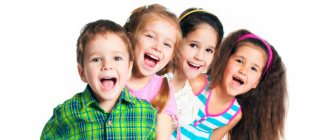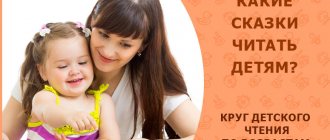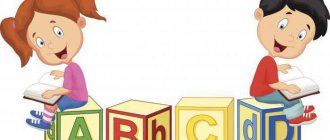The relevance of the problem of social and moral education in preschool educational institutions
Currently, the problem of social and moral education is very relevant and complex.
Changes in society, criticism of certain processes of social life, the emergence of new social phenomena have led to the fact that manifestations of kindness and compassion, love and empathy have become increasingly rare. In society, material values have come to the fore; they prevail over spiritual values. Manifestations of child cruelty and aggressiveness of children towards each other and towards loved ones are becoming more and more common. It has become more difficult for children to build friendly relationships; it is difficult for them to agree on joint actions during play activities. Modern cartoons rarely pursue the task of moral education, therefore, under the influence of these cartoons, children's ideas about moral qualities - about mercy, justice and kindness - are distorted. But despite the changes taking place in society, the education in children of moral qualities, emotional attitude towards loved ones and others must remain unchanged. Therefore, the moral education of children is one of the key tasks.
Are you an expert in this subject area? We invite you to become the author of the Directory Working Conditions
Preschool age is the most sensitive for developing moral rules and norms of behavior, the ability to empathize and compassion. That is why it is necessary at this age to lay the correct foundations of the child’s personality. At preschool age, the formation of the child’s personality begins, his worldview, understanding of evil and good, reaction to the actions of other people are formed, and behavioral characteristics are formed. At this age, the child develops an attitude towards the Motherland, respect for others, goodwill, and a desire to help others.
Fiction as a basic component of social and moral education
One of the basic components in the education and formation of personality is fiction, which acts as a source of moral and aesthetic standards, a translator of the traditions of society and its culture. Performing a cognitive function, fiction broadens the horizons of readers of all ages, shapes artistic taste, and provides emotional experience.
Finished works on a similar topic
Coursework Goals and objectives of fiction in a preschool educational institution 480 ₽ Abstract Goals and objectives of fiction in a preschool educational institution 260 ₽ Examination Goals and objectives of fiction in a preschool educational institution 210 ₽
Receive completed work or specialist advice on your educational project Find out the cost
In the process of becoming acquainted with fiction in preschool age, the child learns about such moral categories as goodness, conscience, justice, honor, sympathy, compassion, duty, courage. Moral education is not achieved by talking to children about morality and virtue. The task of fiction is that when reading it, make children experience the moral moods, actions and feelings of the heroes of the work. And if these moral and emotional states are experienced in the child’s imagination, then the educational goal will be achieved.
Note 1
Fiction is an effective means of developing the moral qualities of an individual.
While reading, the child gets to know the life around him, nature, gets acquainted with the work of people, with his peers, with their joys and failures, experiences and feelings. The literary word has an impact not only on the child’s consciousness, but also on his feelings and actions.
Reading fiction provides an opportunity to compensate for the lack of communication in children, allows them to broaden their horizons and enrich their moral experience. In the process of reading, children develop an emotional relationship to the events described in the work, to the heroes of this work, and also form an attitude towards nature and the people around them.
Works of art always contain some kind of assessment of events. At the same time, in the process of solving the problem of educating moral qualities, it is necessary to use both classical literary works and modern ones.
Works of art open up children to the world of human feelings, arouse interest in personality, in the inner world of a literary character. And having learned to empathize with the characters of works of art, children begin to be more attentive to the people around them, they begin to notice their mood, the mood of loved ones. Then humane feelings begin to awaken, children show the ability to show care and kindness, a desire for justice arises and a protest against unfair treatment of someone.
Thus, reading fiction in a preschool educational institution performs the following tasks:
- Forming in children the idea that books contain a lot of interesting and educational information
- Deepening knowledge about illustrations and their meaning in the book
- Formation of the skill of moral evaluation of a work
- Developing the ability to empathize with heroes
Article:
Today, during my consultation, I will try to tell you about the impact of reading fiction on the development of all components of children’s oral speech.
Speech development occupies one of the central places in preschool education, this is explained by the importance of the period of preschool childhood in the child’s speech development and its formation. During these years, the child masters the sounds of his native language, learns to pronounce words and phrases clearly and grammatically correctly, and quickly accumulates vocabulary.
This direction is presented in the Federal State Educational Standards of Preschool Education in the educational field of “speech development”.
A fiction book provides excellent examples of literary language.
In stories, children learn laconicism and precision of language;
in poetry - musicality, melodiousness, rhythm of Russian speech;
in fairy tales - accuracy, expressiveness.
From the book, the child learns many new words and figurative expressions, his speech is enriched with emotional and poetic vocabulary.
Fiction is an important source and means of developing all aspects of children's speech. Various genres of literature and folklore works lay the foundation for the formation of love for the native language, its accuracy and expressiveness, accuracy and imagery
According to V.A. Sukhomlinsky “Reading books is the path along which a skillful, intelligent, thinking teacher finds the way to a child’s heart.” But, what is very important, by reading a book to a child, leading him along this path, we contribute to the development of his oral speech.
What components does oral speech consist of?
Nurturing the sound culture of speech Formation of the grammatical structure of speech Formation of the lexical structure of speech (dictionary) Development of coherent speech
Sound culture of speech
Mastering the sound side of language includes two interrelated processes: the formation of a child’s perception of sound language, i.e. formation of phonemic hearing and formation of pronunciation of speech sounds.
Reading books to children serves as one of the conditions for the development of hearing, and on this basis, the acquisition of language.
Small literary forms are great helpers in this - tongue twisters, tongue twisters, riddles, nursery rhymes, poems. They help in working on diction, tempo, volume of speech, development of the vocal apparatus, and improve articulation.
They give, without much edification, norms of behavior that the child masters under the influence of his own positive emotions:
“Ay, okay, okay, okay, We are not afraid of water, We wash ourselves clean, We smile at the children.” (a nursery rhyme)
Grandfather Danil divided the melon -
A slice for Dima, a slice for Dina
(Tongue Twisters)
A gander walked in single file with a gander. The gander looks down on the gander. Oh, the gander will pluck the gander's sides.
(pure language)
Having learned to listen to someone else's speech, the child gains the ability to remember its content and form, and to assimilate the norms of literary speech.
It is very important to pronounce these forms so that children feel the sonority, musicality, rhythm, and imagery of expressions. Pure twisters, tongue twisters, nursery rhymes were probably invented by the people so that children and adults could correctly and clearly pronounce all the sounds of their native language.
“Speak not so much to the ear as to the eye,” advised K. S. Stanislavsky. — in preschool childhood, special expressiveness of an adult’s speech is required when presenting literary material.
Formation of grammatical structure of speech
This is morphology - changing words according to tenses, numbers, genders, persons.
Word formation.
Syntax – construction of various sentences.
Let's take a look at the famous Russian folk tale “The Hare is Boasting.”
It is small, but reading it to children, we show all the richness of the grammatical structure of speech:
formation of plural nouns in the nominative and genitive cases. hare-hares-hares;
formation of nouns with an increasing meaning using the suffix -ish-
not a mustache, but a mustache,
not paws, but paws,
not teeth, but teeth;
the presence of simple and complex sentences: “the hare got scared”, “aunt crow went to look for the braggart and found him under a snag.” And, most importantly, the discussion of the heroes of this fairy tale, their actions, will force children to express all the diversity of grammar. After all, the fairy tale is very “juicy” and good for discussion with children. I want to say a lot about such heroes as the crow and the hare, using a variety of words and sentences, putting a semantic connotation into them. Our literature is rich in such tales. The main thing is to introduce children to them!
Formation of the lexical structure of speech (dictionary)
This is the enrichment of children's vocabulary, its activation, clarification of the meanings of words, as well as the content side of the word.
Vocabulary can be passive or active. Passive vocabulary is those words that the child understands. Active vocabulary is the words that the child speaks. An active, rich vocabulary indicates a person’s level of intellectual development. By reading fiction to children, we introduce children to words that are completely new to them and not common in everyday communication.
In this case, the teacher takes full responsibility for explaining the words, helping children enrich their speech. Fairy tales, poems, stories are used for this. They are unusually rich in phraseological units and figurative expressions of colloquial speech. For example, “black horse”, “crackling frost”, “well done Sagittarius”, “visibly and invisibly”, “jack of all trades” and many others characterizing human behavior and natural phenomena. A child, constantly hearing similar expressions in the text of a fairy tale, makes them part of his own speech.
But, there are other literary forms that force the child to see the secondary meanings of words, to form their own ideas about the figurative meaning of the word, its polysemy. These are riddles!
A riddle is a game of recognition, guessing, exposing what is hidden and hidden. And the riddle is loved and interesting by the child. By playing riddles, the child seems to be passing an exam on knowledge and intelligence; is he well acquainted with the world around him? Does he know the signs, qualities, properties of objects and phenomena? A riddle, according to K. D. Ushinsky, “provides a useful exercise for the child’s mind.” Guessing riddles requires careful observation of objects and phenomena surrounding a person.
It is much more difficult for a child to guess a metamorphic riddle than a descriptive one. This is explained by the difficult understanding of the figurative structure of the riddle language. Therefore, it is necessary to teach the child to perceive the figurative content of riddles and explain them.
For example, in addition to the main meaning of the verb go (“to move”), the child is aware of others: a mechanism operates, “They go around the clock, they don’t stand for a minute, but everything is in one place” (“the clock is passing”); “Look out the window: it’s moving.” long Antoshka” (it’s raining).
Or, posing a riddle to children: “Grandfather builds a bridge without an axe.” Children guess - “Frost”. I ask, how did you guess that it was frost? What bridge is he building? Why do they say this? Then I make another riddle about frost and ask you to pay attention to the words used about it:
At night the glazier came into the yard and glazed every puddle with ice. In the morning the sun rose over the city, this glass instantly melted. At night the glazier will come again, He will look at the puddles, he will clasp his hands, He will threaten someone in the darkness with a stick, He will glaze every puddle again.
Which riddle did you like best and why? With the children, we select definitions for the word “frost” and recall other riddles on this topic. Later, when children understand the genre features of riddles, you can invite them to come up with riddles about objects and phenomena using
diagrams, mnemonic tables, algorithms.
Development of coherent speech
We would really like every child to be able to express their thoughts meaningfully, competently, correctly, coherently and consistently.
When talking about working on coherent speech and fiction, we, first of all, turn to fairy tales, poems, and stories. We rely on them in retellings, descriptions, learning poems, dramatizations, and inventing endings (fairy tales, short stories).
When retelling fairy tales and stories, children need to answer questions related to the content, the relationship of the characters, and pay attention to the words with which the author characterizes the characters themselves and their actions.
A correctly posed question forces a child to think, reflect, come to the right conclusions and at the same time notice and feel the artistic form of the work.
Thus, as a result of learning basic analysis of the features of a literary text, speech is improved (vocabulary, coherence, grammatical correctness, sound culture, imagery),
At the same time, it is enriched by the words and expressions he remembers.
Reading literary works brings to the consciousness of children the inexhaustible wealth of the Russian language, and contributes to the fact that they begin to use this wealth in independent activities - verbal creativity.
Speaking about coherent speech, we cannot help but talk about memorizing poems.
When memorizing poems, we highlight the rhythmicity, musicality, melodiousness of poems, developing in children the ability to notice the beauty and richness of the Russian language, we draw children's attention to the content, teach expressive reading, finding the right intonation, correctly placing logical stress, observing pauses, controlling their voice ( raising or lowering it in the right places).
A talentedly written poem with the power of the beauty of its style will help a child see and create an image, for example, “White Birch” by S. Yesenin.
The white birch tree under my window was covered with snow, like silver.
On the fluffy branches, like a snowy border, white fringed brushes blossomed.
And the birch tree stands in sleepy silence, And the snowflakes burn in golden fire.
And the dawn, lazily walking around, sprinkles the branches with new silver.
In a drawing class, any child will see a winter birch tree like this.
Poems teach children to listen to words and sounds - phonetic hearing develops, this is necessary to prepare for reading and writing, this is a model of grammatical and lexical speech.
Nothing develops oral speech more than children’s theatrical activities. It affects the degree of language acquisition and the expressiveness of children’s speech.
Fiction provides rich material for artistic and speech activity. Children act out nursery rhymes, poems, and fairy tales that they know, using elements of costumes and with the help of various types of theaters.
Conclusion.
In the era of computer games and an abundance of toys, children are less and less interested in fiction. However, we should not forget that it is precisely this that partially ensures the cultural development of the child and the formation of his speech.
Reading is important and necessary. This has a beneficial effect on the development of coherent speech, enriches speech with popular expressions, phraseological units, and synonyms. Without reading, a person does not develop, does not improve his memory, attention, imagination, does not assimilate and use the experience of predecessors, does not learn to think, analyze, compare, and draw conclusions.
The ability to understand a literary work (not only the content, but also elements of artistic expression) does not come to a child by itself: it must be developed from a very early age. In this regard, it is very important to teach children to listen and perceive a work of art.
The teacher must be competent in matters of children's reading, must be able to use various means, techniques, methods in order to make children's acquaintance with literature as vivid and interesting as possible.
The teacher faces an important task - each work must be conveyed to children as a work of art, reveal its intent, infect the listener with an emotional attitude towards what they read: the feelings, actions, lyrical experiences of the characters.
In this regard, it is very important to develop in children the ability to actively listen to a work, to listen attentively to artistic speech. Thanks to these skills, the child will develop his own bright, imaginative, colorful, grammatically correct speech.
I would like to wish all teachers that the children in the group are drawn to reading. And at any age, at the words “let’s read with you, guys,” rattling chairs and happily talking, they sat down to listen to His Majesty – the Book!



